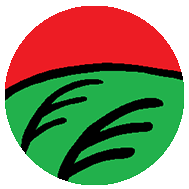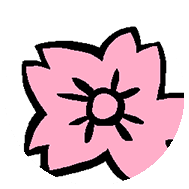Musashino-bana [武蔵野花] is an attested Hanafuda fishing game that was thought to be played during the Edo period.
It is mentioned in Part 1 of the Chapter, “Indoor Games All Around the World” [古今室内遊戯余談, kokon shitsunaiyūgi yodan], written by Koichiro Naganuma, which appears in pages 9-11 of the Japanese Magazine, “Manners and Customs Pictorial Report” [風俗画報, Fūzoku gahō] No. 381, on March 10, 1909.
Originally not being given any name, the game was termed “Musashino” by hanafuda researcher Yasumasa Otsuka, after an old term for hanafuda decks made during the Edo period.
The game can be played by 3 players, or 4 players playing in teams of 2. If playing in teams, then each team shares the same capture area.
It plays like a typical Hana-awase game but without any card points or Teyaku. The unique feature of this game is in the names of the Dekiyaku, which seem to only make sense in the context of old hanafuda designs.
¶ Setup
Like many hanafuda games, a decision must first be made as to how many rounds to play - 12 rounds is traditional, though 6 and 3 are options for shorter games. Any other house rules should also be established at this point in order to keep gameplay smooth and fair.
Also, there is no attested scoring system; however, since players only obtain points through forming Dekiyaku, it is assumed that the same scoring system for Taiyaku was used.
¶ Equipment
A 48-card Hanafuda card deck is used, preferably an Echigobana deck, since it is closest to what kind of decks would be used during the old days.
¶ Choosing The Dealer
No method is stipulated for choosing the dealer. A hanafuda-specific method involves each player drawing a card from the deck, and the player with the earliest month becomes the dealer. In the event of a tie, the highest-ranked card within the month is considered the earliest. If there is still a tie, then the players re-draw.
The winner of the round becomes the dealer for the next round.
¶ Distributing The Initial Cards
After shuffling the deck, the cards are distributed.
In the three-player version of the game, 7 cards are dealt to each player, and 6 cards face-up to the table.
In the four-player version of the game, either of the two can be used:
- 5 cards are dealt to each player, and 8 cards face-up to the table.
- 6 cards are dealt to each player, and no cards to the table.
The remainder of the deck is placed face-down to form the draw pile.
If 4 cards of the same month are dealt to the table, then a misdeal is declared (since these 4 cards are impossible to capture). In this case, the cards are thrown in, shuffled again, and re-dealt.
¶ Gameplay
In each round, the dealer is the first to play, and turn to play passes anti-clockwise around the table. The gameplay is the same as in Hana-awase, and the round ends when either all players run out of cards in hand, or if a player or team forms an Insta-Win Dekiyaku.
¶ Storm Rule (Optional Rule)
There are two different ways to implement the Storm Rule:
- If a player captures the
 Rainman or the
Rainman or the  Lightning card, Any
Lightning card, Any  Full Moon,
Full Moon,  Curtain, or
Curtain, or  Cherry Blossom Poetry Ribbon an opponent has cannot be used to form a Dekiyaku (i.e. whatever Yaku is formed using those cards will not be counted at the end of the round).
Cherry Blossom Poetry Ribbon an opponent has cannot be used to form a Dekiyaku (i.e. whatever Yaku is formed using those cards will not be counted at the end of the round). - If a player captures the
 Rainman or the
Rainman or the  Lightning card, then an opponent’s Moon Banquet and Flower Banquet Dekiyaku are invalidated.
Lightning card, then an opponent’s Moon Banquet and Flower Banquet Dekiyaku are invalidated.
¶ Sun Rule (If Storm Rule is used)
If a player used the Rainman or Lightning card as per the Storm Rule, if an opponent then captures the ![]() Crane, then the effects of the Rainman or Lightning card are invalidated.
Crane, then the effects of the Rainman or Lightning card are invalidated.
¶ Scoring
If a player or team forms an Insta-Win Dekiyaku, the round stops immediately, and the player/team wins. The losing players/team must pay the winning player/team 8 points.
This amount is only assumed; it is not mentioned in the book how many points an Insta-Win Dekiyaku is worth.
Otherwise, all players/teams check for all Dekiyaku they formed, and calculate the total Dekiyaku points they have obtained.
The player/team with the most Dekiyaku points wins, and the losing players/team must pay the winning player/team the difference of their score to the winning player/team.
¶ Dekiyaku
Dekiyaku in this game are classified by their value and composition.
Note that all Yaku stack, except:
- If a Lightning card is added to Three Brights to form Four Brights, then only the points for Four Brights are counted.
Also, if an Insta-Win Yaku is formed, the winner receives points for the Insta-Win Yaku only.
| Value | Name of Yaku | Composition |
|---|---|---|
¶ Insta-Win Yaku (Worth 8 points) |
||
| 8 | Five Kings 五王 [ごおう, go-ou] |
Not all of the cards in this Yaku shine, which is why it is not called “Five Brights”. THIS DEKIYAKU STOPS THE ROUND. |
| 8 | Seven Red Ribbons 七夕 [しちせき, shichiseki] |
THIS DEKIYAKU STOPS THE ROUND. |
¶ Four Card Yaku (Worth 4 points) |
||
| 4 | Four Brights 四光 [しこう, shikou] |
Cards in this set actually shine. Optional: Some players at the time prefer using the |
| 4 | Kemari Court 鞠懸 [まりがかり, marigakari] |
The flowers in the cards represent the four trees planted in four corners of a Kemari court: A Pine tree, a Cherry tree, a Maple tree, and a Willow tree. |
¶ Three Card Yaku (Worth 2 points) |
||
| 2 | Three Brights, a.k.a Sun-Moon-Star 三光 [さんこう, sankou] |
The term “Three Brights” originally refers to the Sun, the Moon, and the Star (actually the planet Venus [金星, kinsei]) |
| 2 | Takasago 高砂 [たかさご, takasago] |
Mnemonic: A couple raises a |
| 2 | Front Sugawara 表菅原 [おもてすがわら, omote sugawara] |
Based on the Kabuki play “Sugawara Denju Tenarai Kagami,” the names of the three sons of Michizane Sugawara’s vassal Michizane Shirokurō were |
| 2 | Back Sugawara 裡菅原 [うらすがわら, ura sugawara] |
They correspond to the Three Poetry Ribbons in Hachi-Hachi, and are also composed of Pine, Plum and Cherry flowers. |
| 2 | Purple Ribbons 紫短 [むらたん, muratan] |
The original name for Blue Ribbons. In fact, they are still printed in a purple color in modern hanafuda decks to this day. |
| 2 | Large Birds 大鳥 [おおとり, ohtori] |
|
| 2 | Small Birds 小鳥 [ことり, kotori] |
The small birds are drawn smaller in old Hanafuda cards. |
| 2 | Crop Pests 野荒し [のあらし, noarashi] |
Not to be confused with Boar, Deer, Butterflies, a Yaku that does not exist in this game. |
| 2 | Three Red Flowers 三紅 [さんべに, san beni] |
A The type of card in this Yaku is only an assumption, as the original text mentions “Three Purples and Three Reds in Flowers”, and that the main illustration in Chaff cards is the flower itself. |
| 2 | Three Purple Flowers 三紫 [さんむら, san mura] |
A It is also assumed that the Yellow Paulownia Chaff is not included in this Yaku. |
¶ Two Card Yaku (Worth 1 point) |
||
| 1 | Coat of Arms 菊桐 [きくぎり, kiku-kiri] |
Two Coats of Arms of the Imperial Family. |
| 1 | Moon Banquet 月の宴 [つきのうたげ, tsuki no utage] |
|
| 1 | Flower Banquet 花の宴 [はなのうたげ, hana no utage] |
|
| 1 | Autumn Leaves 紅葉の賀 [いちょうのが, ichou no ga] |
|
| 1 | Cuckoo with Moon 月ホト [つきほと, tsuki hoto] |
|
| 1 | Butterflies with Flowers 蝶花 [ちょうか, chou ka] |
|
| 1 | Boar with Peony 獅子牡丹 [ししぼたん, shishi botan] |
This is a reference to Karajishi [唐獅子, Chinese Lion] sitting on a Peony flower, but the Lion is replaced with a Boar. On a side note, Botan Nabe refers to a hot pot of wild boar meat. |
¶ Four-of-a-kind Yaku (Worth 1 point) |
||
| 1 | Plum Blossom Pot 梅壷 [うめつぼ, ume tsubo] |
|
| 1 | Wisteria Pot 藤壷 [ふじつぼ, fuji tsubo] |
|
| 1 | Iris Bridge 八ツ橋 [やつはし, yatsuhashi] |
|
| 1 | Paulownia Pot 桐壷 [きりつぼ, kiri tsubo] |
|
¶ Contradictions regarding the Lightning card
The game mentions the use of a lightning card, and the book also mentions that the Willow cards all have secenery on them.
However, actual Musashino cards don’t have a “lightning” card; instead, lightning is drawn on the Rainman card, where the Rainman is thought to depict Ono Sadakuro (as opposed to Ono no Michikaze in modern Hanafuda decks).
On the other hand, the Willow Chaff in a Musashino deck looks typical of other Chaff, containing nothing but Willow branches on the card.
¶ Bibliography
- https://mixi.jp/view_bbs.pl?comm_id=49586&page=all&id=4614383
- 明治41年3月10日「風俗画報」第381号9~11ページ 永沼小一郎「古今室内遊戯余談」前編